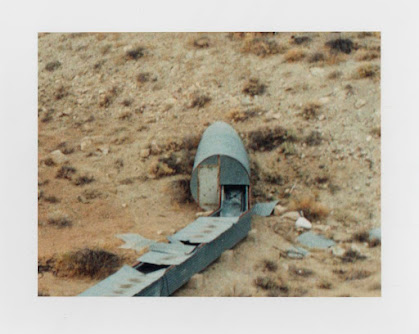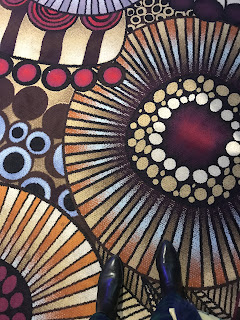Her reply surprised me; Jessica said she missed driving around that area. Via text, she revealed her storied past in the Southwest—Utah, California and the Mojave. As an artist in residence at the Center for Land Use Interpretation in Wendover, Utah she’d embarked on her first exploration of decommissioned military sites and nuclear silos around the area, which led to more work on the topic. The conversation piqued my curiosity about my new home, and it created an unexpected connection with a friend whose past projects were news to me. After reading more about the colorful history of the Atomic Desert and the artwork it has spawned, I was inspired to inquire more deeply into Jessica’s work.
Which of your desert-centric explorations of decommissioned space did you propose to the Center for Land Use Interpretation? Did you develop the project specifically
for the residency? Did these projects relate to photographic work you were already doing?
What I proposed and what I ended up doing were very different. My proposal was to continue working on a photo series I had been doing involving a model rocket with a tiny camera on it. This was 2001, way before GoPros, Google Earth, etc. It was a still camera that used 110 film, which produced tiny and very grainy negatives. The moment the rocket fell back to earth, the nose cone separated from the body and the shutter was released. I would launch the rocket and then at the moment it took its picture of the ground from 500 ft in the air (presumably with me in it), I would photograph it. The two photos, one from the rocket's perspective, and one from mine, were then displayed as diptychs.

Jessica Sowls, Corrugated Tunnel from Reconnaissance series, 2007How did you find the sites you ended up photographing? What's your relationship to the American southwest, particularly those desert areas-- Utah and California? How did you start thinking about those spaces?
I was at the CLUI compound in Wendover for two months, with nothing to do but explore and read about the history of the region. They had published a book about interesting military and industrial sites in the region, fashioned as a travel guide. I spent a lot of time driving to all the sites, and became fascinated with these secretive places that were hiding in plain sight, with vague signs, many miles of fencing, and white SUVs that would appear out of nowhere when I got too close. There was a sense of foreboding everywhere. The residency housing is on a decommissioned army base, surrounded by abandoned barracks and right next to an enormous rusted airplane hangar. The base was built in WW2 and used as a top secret place to assemble the atomic bombs that were dropped on Japan and training the pilots that flew the missions. The rusty hangar was for the Enola Gay.
This loaded atmosphere led me to want to do more "serious" work about the military. There was an interesting part of the old airfield on the base that had ruins of large ramps that were used to test the German V2 rockets that the US had confiscated during the war. At that point, these were the only rockets that had been invented, and the Americans were trying to reverse engineer their technology. So there I was, at the very spot the first rockets were launched on this continent. During this time I talked a lot with CLUI founder, Matt [Coolidge], who has an encyclopedic knowledge of the military industrial complex in the west, and he was suggesting other sites in the area. The next site in rocket history was not too far away, just a lone, unmarked, concrete bunker next to an asbestos disposal facility. It was there that the first missiles were launched. Rockets turned into missiles, and I just followed the trail, which took me to southern Utah, New Mexico, and Los Angeles. It was fascinating to learn about how the military evolved during the cold war, all while seeing changes happening in real time in response to 9/11.

Jessica Sowls, Missile Project, 2002-4; The rusty ball on the floor is a gas tank for V2 rockets. Transparency film was displayed in 2x2” lightboxes.
Do you think there's something inherently "boy" to military/spy technologies?
It was not lost on me that my project was focused on a very phallic object. I thought of it as a distillation of the hypermasculinity of the military, wars, environmental destruction, etc. What better symbol of it all than a giant cock? Also I just liked how it all came back to this little model rocket I bought for fun.
So I finished one series for the residency- photos of the missile launch sites and an accompanying booklet with the research I had done. I wanted to do more work in the area, so a few years later I came back to photograph the military sites from a different perspective. I was thinking more about what it felt like to be there while knowing what these innocuous looking ruins and giant swaths of fenced-off desert actually stood for. I pictured myself as a spy, decades too late to be of any use, futilely photographing cold war sites long after the cold war ended. My second project was a series based on that idea, grainy and washed out photos that looked a lot like the ones the model rocket took.
It's funny, the concept of being marooned at a residency with nothing to do but drive through desert sites and read about faded American history sounds so romantic, but quarantine has demonstrated that isolation can really drain creative focus.
What was the appeal of desert seclusion for you? What was the allure of the Southwest? As a Las Vegas resident, I'm trying to understand my own mystification of place--what drew me to move here. Did your time in LA [working at the Museum of Jurassic Technology] contribute to a sense of desert mystique?
I loved the work of Richard Misrach, and had absorbed messages about the freedom of the west from films like My Own Private Idaho and Paris Texas. The mystique is part of our culture- Easy Rider, Peewee’s Big Adventure, etc. When I first drove out to Utah from Minneapolis, I was amazed at how far I could see. A thunderstorm that looked to my midwestern eyes as if it were 10 minutes away was over an hour away. Everything was laid bare, all these military industrial sites were out in the open, you could drive around them and see everything (seemingly). It was as if a new way of seeing was shown to me. On all the dirt roads there were overturned rusted out cars shot full of bullet holes- so dramatic! The colors in the sky and the quality of light made photographs look better.
As for ending up at CLUI, I just thought it looked interesting. And they paid residents $500/week, and I needed money and wanted to get out of the midwest. Simple as that.
You’re right, isolation is so emotionally draining. And yet I’ve put myself in isolating situations many times because it feels familiar to me. It’s definitely one of my unhealthy reenactments of childhood.

Jessica Sowls, Seneca Army Depot (Upstate New York), photograph, 2007
If you found yourself alone in the desert in 2020 what would you do now?
Alone in the desert now... it would be interesting to do a rephotographic survey in the style of Mark Klett. How have these military sites changed? Is accessing them more difficult in the age of terrorism? I spent most of my time out there in 2002-3, before much of the funding for stricter security actually went into effect. On a return visit in 2007ish, for the "Reconnaissance" series, things had changed a bit, but most places could still be accessed.
I'd also like to expand a project I started when living in upstate NY, but never did anything with. I was working at the Cornell library, digitizing aerial photos of the entire state taken from an airplane in the 1960s. I became fascinated with the photos that showed the construction of interstate highways across the landscape, and the ones that showed the now abandoned Erie Canal. "Progress" in the making and discarded, both unnatural slashes across the landscape, like ancient earthworks. I saved the aerials, with GPS coordinates, and drove around photographing what they looked like now. If aerials like that exist in a western state, it could be a good compliment to that project.
Do any of the ways of working or insights that you developed during these projects influence your creative work now? Feel free to use this as an opportunity to contextualize what you're up to now.
My creative artwork now is barely existent. I discovered that I enjoyed being creative with food more than what the kind of work I was doing was inevitably turning into- a lot of time on the computer. The earlier projects were shot on film and printed in the darkroom. That method was becoming hard to access and digital means had replaced film. The exploring and shooting was still available to me, but I never wanted to do anything with the work after that.
The biggest lesson I learned from the CLUI experience was the harder I tried to make something that encompassed everything I wanted to say, the more difficult it became to make anything at all. I was fresh out of art school, just 23, when I got the residency and an additional emerging artists grant. I wanted to prove myself so badly. My own perfectionism ruined my art career.

























